Camp Dix - A.E.F. Training Center - New Jersey

Camp Dix, New Jersey was named in honor of Maj. General John Adams Dix, U.S. V., who served as Secretary of the Treasury under President Buchanan. Established July 18, 1917, to serve as training camp for 78th Division (National Army), which occupied the cantonment, August 1917 to May 1918. Construction started June 12, 1917 and continued through 1918. After May 1918, used as embarkation camp. Designated as demobilization center, December 3, 1918 and as debarkation camp 1919. Retained as permanent reservation.
Camp Dix Collection
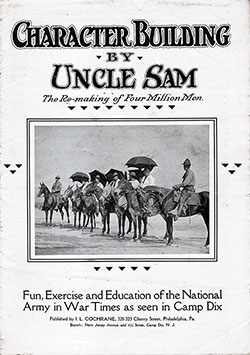
Character Building at Camp Dix - 1918
Character Building by Uncle Sam: The Re-Making of Four Million Men: Fun, Exercise and Education of the National Army in War Times as seen in Camp Dix. Large Format Booklet 16 Pages of Photographs and information.

Pictorial Review - November 1917
The first Issue of the Camp Dix Pictorial Review: A Picture History of a National Army Contonment, Wrightstown, New Jersey, November 1917 documents the building of Camp Dix along with its famous builders, Artillery Companies, and Officers.The paper was produced for the soldiers, parents, and friends.
Featured Articles
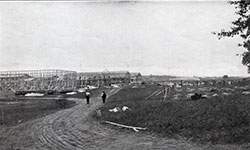
A photographic exhibit documenting the monumental tasks involved in building a World War 1 Army cantonment during 1917 near Wrightstown, New Jersey, a borough in Burlington County. Camp Dix was later renamed Fort Dix - a Joint Base McGuire-Dix-Lakehurst Army post.
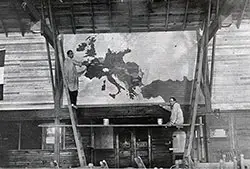
An interior scene of YMCA Hut No. 10 located in the Base Hospital section of Camp Dix. This one is altogether different from any other building in camp.
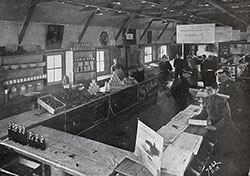
When Camp Dix was first opened, each exchange building was occupied by a Regimental or Battalion Exchange, run by an officer from that unit, and all profits were paid into the regimental or battalion funds.
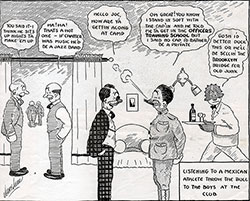
Cartoons and Comic Strips from Camp Dix Newspapers
In the multitude of men gathered from all walks of life, musicians, vocal and instrumental, monologue artists, humorists, and cartoonists will be found; some of them with a surprising degree of talent and in sufficient number to provide entertainment that might even please the fastidious vaudeville goers of the great city.
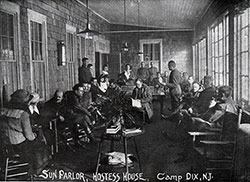
The Hostess House at Camp Dix - 1918
Delightfully and cheerily arranged, a rest spot for mind and body. A place where mothers, wives and sisters met their boys. Ladies from the Travelers’ Aid Society brought the home folks from the railroad station to the Hostess House.
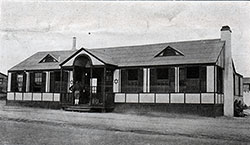
Jewish Welfare Board at Camp Dix - 1918
When the Camp was young, one of the first men we had the pleasure of meeting was Cyrus Janover, Camp Dix representative of the Jewish Welfare Board. He was in Camp when the first selected men arrived, on September 5, 1917.
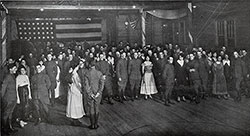
Knights of Columbus - Everybody Welcome - 1918
The Knights have four buildings in Camp Dix, where every soldier is welcome to enjoy the movie shows, the dances, the pool tables, reading matter and general sociability.
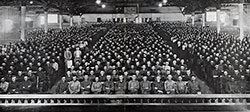
The Liberty Theatre at Camp Dix - 1918
Now the men at Camp Dix can go to the Liberty Theatre seven nights a week, with matinees Saturday and Sunday, and see a first-class production for ten, twenty-five, or fifty cents.
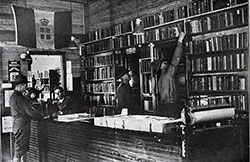
The American Library Association has taken an important step in solving this problem by instituting at each of the cantonments a camp library. This institution, which is pictured above, is completely equipped.

List of Materials Used in Construction - 1917
Mechanical ability, supported and guided by modern, efficient business practice, made it possible to build barracks so rapidly as to surprise the hustling army men in charge. Below is a list of all the materials used during the construction of Camp Dix.

The Mole-Tequop Club in Wrightstown - 1918
Excellent meals are served, but those real pies will be remembered and told about when the veterans are old men and swap war yarns, as do those of the Civil War. “Do you remember those pies of the Molly what-do-you-call-it Club?”
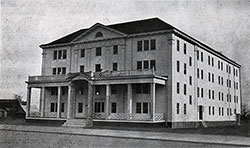
Salvation Army Hostel - Wrightstown - 1918
The largest building in Wrightstown is the Salvation Army Hotel, officially the Salvation Army Military Hostel, opened November 21 by Secretary of War Baker. The good work of the Salvation Army “Over There” is praised in many of the letters sent back by the boys.
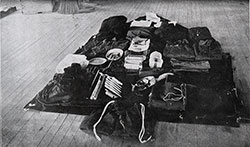
The Soldier's Overseas Equipment - 1918
The greater part of the following list was provided every soldier prior to embarkation. Naturally, the equipment varied with the character of the regiment. Items marked (MC) were issued to men of the Medical Corps only.
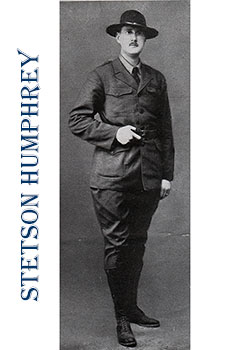
Song Leader - Stetson Humphrey - 1918
A singing army is a winning army. Recognizing this officially, Uncle Sam, acting through the War Department Commission on Training Camp Activities, has assigned a Song Leader to each of the big Training Camps, the one at Camp Dix being Stetson Humphrey.

Pictorial Review - February 1918
Digitization and Transcription in Progress

Pictorial Review - 20 March 1918
Digitization and Transcription in Progress

Camp Dix Pictorial Review - 20 April 1918
Digitization and Transcription in Progress

Camp Dix Pictorial Review - 20 May 1918
Digitization and Transcription in Progress

Camp Dix Pictorial Review - 20 June 1918
Digitization and Transcription in Progress

Pictorial Review - 20 October 1918
Digitization and Transcription in Progress

Camp Dix Pictorial Review - 20 July 1918
Digitization and Transcription in Progress
- 1917 Camp Dix Newspapers, Start: August 16, 1917, End: November 24, 1917, Reel #1, Microfilm Format.
